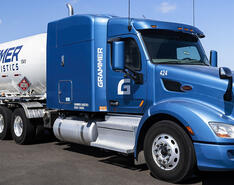
Do your employees have the tools they need for tech-enabled customer service? Whether your team is frustrated over missing paper tickets or they can’t find the data they need to answer customer queries, their stress can actually negatively contribute to your customers’ experience and create a self-feeding cycle.
To improve employee engagement and customer service, team members need tools and systems that streamline the customer experience. One of the best ways to do this is adjusting workflows and leveraging technology, making it easier for teams to focus on customers and improving the overall experience. By incorporating technology with the following four philosophies, your team can better service customers, keep operations running smoothly and improve their overall work experience.
Philosophy 1: Adopt an Experience-First Mindset
A company with an experience-first mindset makes it easy for customers to do business with them. A small-scale example of this mindset is offering multiple means of contact for customer queries. This might include off-hours phone numbers, an online portal and other communication tools accessible from a company website.
However, the experience-first mindset must continue when the customer request reaches the company, which is only possible when employees have access to the tools, equipment and technologies they need.
This is the cycle of customer experience — when companies take care of their employees, the employees are better equipped to take care of customers, and customer interactions remain positive. For example, larger monitors help back-office employees view more customer data with less scrolling and clicking. Saving a few minutes here and there seems small, but the time savings add up and lead to shorter response times, less stressed employees and happier customers.
Philosophy 2: Make Decisions at the Decision Point
Who has the power to make decisions at your fuel delivery company? Most companies fall into two camps: those that empower employees at all levels to make decisions and those that require escalation before a decision can be made.
Employees need autonomy to make decisions, and often, employees lack this autonomy because technology is being leveraged not as a highway, but as a roadblock.
Consider a customer service representative (CSR) who receives a call asking when a driver will arrive to make a delivery. If the CSR can’t access delivery routes or track driver progress in real time, they will need to delay a response until they can get in contact with the dispatchers or the drivers. In this instance, technology has become a roadblock. But if the company’s software is integrated and data can sync between devices in the field and the back office, the CSR can access the customer’s account in the back-office software and offer an immediate answer.
Similarly, if the company has a backlog of work and a will-call customer makes a delivery request, the CSR can access that data to provide assurances and give an estimated delivery time to the customer. They can even help the customer in the long term by setting up text alerts to notify the will-call customer when tanks hit a certain level, reminding them to put in a delivery request.
Philosophy 3: Streamline Processes
Using old processes with new technology creates speed bumps that delay and complicate operations. As businesses invest in new tech, their processes have to adapt to ensure seamless operations. But how do you know if your software has outpaced your processes? Analyzing every process one-by-one is unrealistic; the better option is to start small by gauging feedback from decision-makers and tackling low-hanging fruit.
Consider processes that cause the most notable stumbles for team members. Go step-by-step and evaluate whether each step is necessary. Also, determine whether established workarounds are required or if they were enacted for systems or strategies that are outdated.
Next, figure out which steps can be handled by software automation. Can tickets be digitally transmitted to a handheld device, or do drivers need to pick up a printed stack of tickets from the office each day? Digitizing the ticketing process ensures that paper tickets can’t be lost, and it saves time and resources for dispatchers and drivers.
Keep in mind that the over-engineering of processes can be just as much of a roadblock as having no automation in place at all — different processes will require unique degrees of manual oversight. While forms and automation can prevent data loss, it takes a discerning eye — and a human touch — to ensure that processes will leave customers satisfied.
Philosophy 4: Prioritize Concerns
If team members notice issues, do they have the time and capability to address them? If not, they’ll likely punt errors forward in a never-ending game of “kick the can” that can snowball into major issues down the line. Every digital process begins with a manual effort.
Usually, this comes in the form of data entry. However, entering the same data multiple times leads to an increased risk of conflicting information. Teams can mitigate this risk by taking advantage of software integration; data such as a customer’s address can be entered into one system and automatically pushed out to others. If a customer moves, the address can be updated in the original software, and the change will sync to all connected platforms.
In addition, reports and dashboards can be helpful tools when it comes to humans reviewing data and identifying anomalies. Contemporary software comes with robust features in these areas, allowing teams to regularly review and analyze data. These reports and dashboards also make it easier for team members to locate and correct errors; some systems notify users of unusual behavior, such as tanks with levels that do not match projected usage.
These tools support the customer-first mindset essential for fuel dealers. After all, teams dedicated to superior customer service are driven to scrutinize data more carefully and flag potential errors before they create larger challenges.
But this philosophy is not just about addressing errors; it’s also about enabling the detail and nuance necessary for five-star customer service. Consider a customer whose delivery location is locked behind a gate with a keypad. An account manager can add the gate code and other relevant information to the customer account. Then, delivery drivers can access the information on their devices to ensure seamless delivery and avoid delays.
Similarly, if a customer’s house is under construction or if other factors pose problems for smooth deliveries, drivers should be able to apply these notes to the customer account via a mobile device. During future deliveries, drivers can access that information and plan ahead for hiccup-free delivery.
Using Tech-Enabled Customer Service to Empower Your Team
The impact of empowered employees, advanced technology and satisfied customers is cyclic and self-fulfilling — as one area is enhanced, the others follow suit. This creates exponential growth and leads to a positive impact on customer reviews and the bottom line. However, it requires teams to be equipped with modern tools, transparent processes and supportive leadership.
In an industry as competitive as fuel delivery, happy employees delivering superior customer care can set your business apart. With thoughtful adjustments to workflows and a commitment to continual improvement, you can break cycles of dissatisfaction and establish a legacy of shared success.


